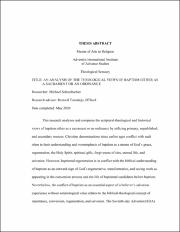| dc.description.abstract | This research analyzes and compares the scriptural-theological and historical
views of baptism either as a sacrament or an ordinance by utilizing primary, unpublished,
and secondary sources. Christian denominations since earlier ages conflict with each
other in their understanding and overemphasis of baptism as a means of God’s grace,
regeneration, the Holy Spirit, spiritual gifts, forgiveness of sins, eternal life, and
salvation. However, baptismal regeneration is in conflict with the biblical understanding
of baptism as an outward sign of God’s regenerative, transformative, and saving work as
appearing in the conversion process and the life of baptismal candidates before baptism.
Nevertheless, the conflict of baptism as an essential aspect of a believer’s salvation
experience without soteriological value relates to the biblical-theological concept of
repentance, conversion, regeneration, and salvation. The Seventh-day Adventist (SDA)
Church with its perspective of preparation and nurture before and after baptism rejects in
its official fundamental belief on baptism as ordinance any sacramental view or notion of
baptismal regeneration. However, some scholars, pastors, authors, and members within
this church uphold baptismal regeneration as similar to Alexander Campbell’s concept of
baptism for the remission of sins. Such concept might be even his concept itself or one
influenced by him or James White.
Chapter 1 introduces the conflict of baptism in Christianity by focusing on
baptismal regeneration and the challenge of goal setting versus the high dropout rate of
baptized members. Chapter 2 analyzes the biblical-theological understanding of baptism
as related to regeneration, conversion, and repentance. Chapter 3 views the conflict of
baptism as a sacrament or an ordinance within Christianity by comparing and analyzing
baptism within Catholicism, Presbyterianism, Lutheranism, Anabaptism, and Adventism.
Chapter 4 investigates the historical development of the fundamental beliefs and baptism
within the SDA Church and Campbell’s influential concept of baptism for the remission
of sins as related to some of the members and pastors of the Christian Connexion-
Restoration Movement and the SDA Church. Such shows the conflict of insufficient
discussion and unified understanding on the practice and concept of baptism within
Adventism by discussing its popular views by some scholars, pastors, authors, members,
and literature within the SDA Church that promote baptismal regeneration. The summary
of Chapter 5 can serve as the basis for future studies on the importance of developing a
scriptural-theological understanding of conversion, regeneration, and salvation as
prerequisite for baptism within Christianity. | en_US |

